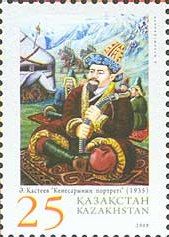Kenesary's father, Kasym Sultan, or Kasym Tore, was born from the daughter of the Dzungar Khuntaiji Galdan Tseren. Kasym, being a noble and wealthy Genghisid (Tore), had several wives and numerous offspring. His elder wife Aikumis was the mother of 6 children of Kasym — Sarzhan, Yesengeldi, Koshek, Agatay, Bopay and Kenesary. Bopay, the younger sister of Kenesary, was an active participant in his uprising. Batyr Nauryzbay, the younger brother of Kenesary, born from the 2nd wife of Kasym, also took an active part in the uprising.[3]
During the 18th century, the influence of the Russian Empire in the Kazakh Juzes increased. In 1731, the Khan of the Junior Juz Abul Khair Khan recognized the protectorate of the Russian Empire. In 1740, the Khan of the Middle Juz, Ablai, also became a Russian citizen. All subsequent Khans were appointed by the Russian government. During the 18th - the first half of the 19th century, the lines of Russian fortifications gradually moved deeper into the steppe. To control the region were built: Orenburg, Petropavlovsk, Akmolinsk, Semipalatinsk and other fortifications.
The rebellion led by Kenesary Sultan took place from 1837 to 1847, with it being characterized as national liberation character. The insurrection was mainly aimed at preserving the independence of the provinces, which were not independent. It was aimed at preserving the independence of the lands that were not part of Russia. The rebellion led by Kenesary Kasymuly aimed not only to stop the colonization of the Kazakh lands by imperialist Russia but also to free the Kazakhs of the southern regions from under the rule of the Kokand.
Kenesary demanded that Russia restore the independence of the Kazakh statehood under Ablai Khan, eliminate taxes and withdraw from the military occupied forts. Kenesary's representatives, who were sent to deliver a letter to the West Siberian Governor-General and Tsar Nicholas I of Russia, were captured and punished.
The Kazakhs of three juzes actively participated in the rebellion of 1837—1847 under the leadership of Kenesary. Batyr Nauryzbai Kasymov, Kenesary's younger brother and his staunch associate was the leader of the detachments during the uprising. In May 1838 Sultan Kenesary's detachments captured the Akmolinsk Prikaz.[4][5]
When Kenesary realized that he could not defeat the Russian forces, he accepted amnesty and joined the Kirgiz struggle against the Khanate of Kokand. He died in battle in Kirgizia in 1847.[6]
Кенесары Касымов // Большая советская энциклопедия : [в 30 т.] / гл. ред. А. М. Прохоров. — 3-е изд. — М. : Советская энциклопедия, 1969—1978.
Казахстан. Национальная энциклопедия, 2004
Работа Е. Бекманханова «Восстание хана Кенесары», с. 17
Olcott, Martha (1995). "The Russian Conquest". The Kazakhs. Hoover Institution Press. p. 65.
